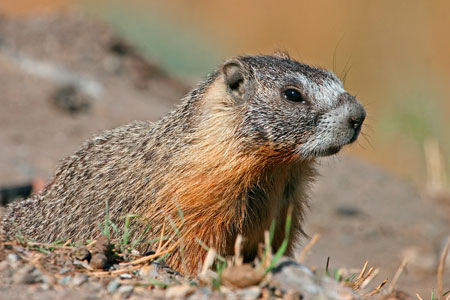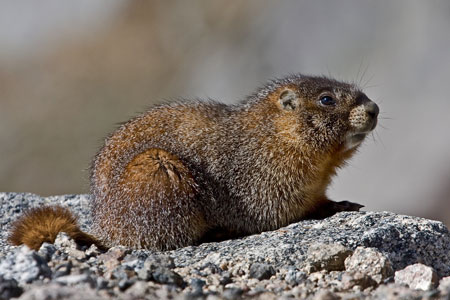

|
Yellow-bellied Marmot (Marmota flaviventris) Description: Marmots are large burrowing rodents, about the size of a housecat, found in the Northern Hemisphere. Yellow-bellied Marmots are mammals with grizzled brownish fur, a yellow belly, and whitish spot between eyes. They have small round ears, a short white muzzle and black nose. The body is heavy-set with short legs and a furry reddish-brown tail. Male marmots are heavier than females, ranging from 3 to 5 kg, while females range in weight from 1.6 to 4 kg.
In Washington, this marmot is always at lower elevations, in more arid situations than the Hoary Marmot. It requires sufficient rocks for shelter and burrows and abundant herbaceous vegetation for food nearby. Click the range map to learn more about the distribution of Yellow-bellied Marmot in Washington. Diet: Yellow-bellied marmots are herbivores - feeding on the leaves and blossoms of a variety of herbaceous plants and grasses. Their also eat grains, legumes, fruit, and occasionally insects. Behavior: Yellow-bellied marmots are mainly diurnal. They spend most of the time on the ground (terrestrial), but occasionally will climb shrubs and trees. 
They hibernate from September to May, although hibernation length varies with elevation. The hibernation burrows may be up to 5-7 meters deep, while their regular burrows are about 1 meter under ground. Yellow-bellied marmots whistle, chuck, and trill when alarmed by predators. Reproduction: Yellow-bellied marmots have a "harem-polygynous" social system whereby a male defends and mates with one or more females in a subalpine meadow. Daughters stay close to home and may settle around their mothers. Sons typically disperse as yearlings, then try to find and defend one or more females. Females tend to breed when they are 2-years old. The litter sizes average around four pups. Only about half of the pups survive their first year. (The Marmot Burrow, UCLA)
Did you know?

Yellow-bellied Marmot photo by Natures Pics More information: Marmota flaviventris Information - Animal Diversity Web The Marmot Burrow - UCLA Marmot Lore 101 - the lighter side of marmots More photos: Yellow-bellied Marmot Photos |
Animal silhouettes available to purchase »
Photos: Natures Pics
Home | About Us | How to Participate | Biodiversity Modules | Projects | Maps | News | Resources